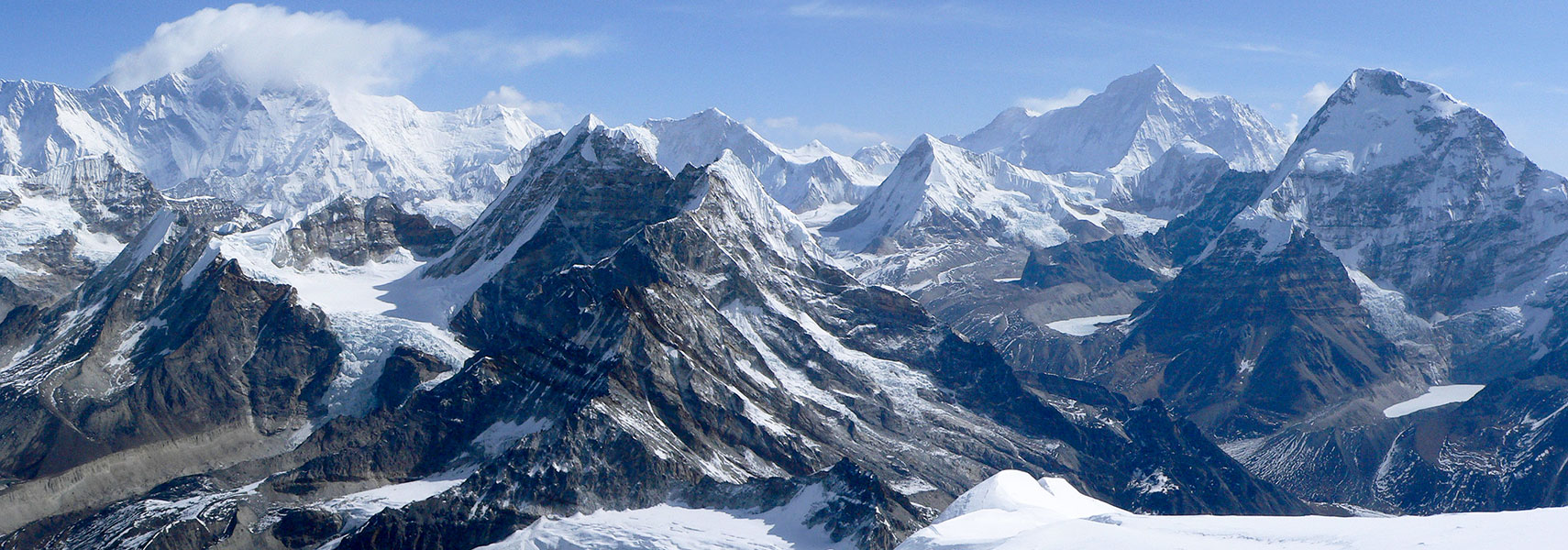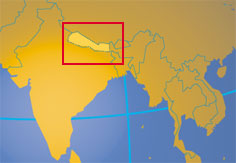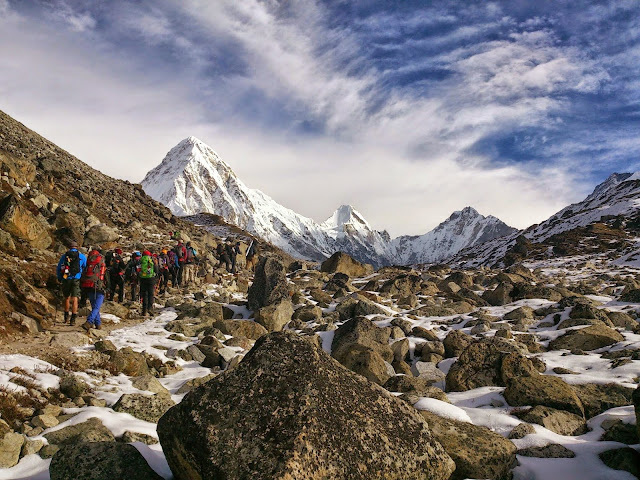Nepal - Country Profile | Culture, History & People
___ Nepal |
 Himalaya mountain range, view from summit of Mera Peak in Nepal's Sagarmatha Zone. Mount Everest, Lhotse and Lhotse Shar (hidden by clouds, left), Peak 41 in center with Baruntse behind; Makalu (8,485 m) and Mount Chamlang (7321 m) to the right. Image: Andrew Grandison |
|
Destination Nepal, a virtual guide to the former Kingdom in the Himalayas between India and China. Officially the Federal Democratic Republic of Nepal, a landlocked country in South Asia bordered by the Indian states of Uttarakhand, Uttar Pradesh, Bihar and Sikkim, and in north by Tibet. The country along the southern slopes of the Himalayan mountain range is host to eight of the 10 highest peaks in the world, including Mount Everest, Lhotse, Makalu, and Kanchenjunga (on the border to Sikkim). With an area of 147,181 km² Nepal is slightly larger than 1.5 times the size of Portugal, or slightly larger than the U.S. state of Arkansas. Nepal has a population 31 million (2016 est.). Largest city and national capital is Kathmandu. Spoken languages: about half of the population speaks the official language Nepali, the rest is using one of the several other Tibeto-Burman languages. |
A landlocked country the size of Arkansas, lying between India and the Tibetan Autonomous Region of China, Nepal contains Mount Everest (29,035 ft; 8,850 m), the tallest mountain in the world. Along its southern border, Nepal has a strip of level land that is partly forested, partly cultivated. North of that is the slope of the main section of the Himalayan range, including Everest and many other peaks higher than 8,000 m.
Government
In Nov. 1990, King Birendra promulgated a new constitution and introduced a multiparty parliamentary democracy in Nepal. Under pressure amid massive pro-democracy protests in April 2006, King Gyanendra gave up direct rule and reinstated Parliament, which then quickly moved to diminish the King's power. In Dec. 2007, Parliament voted to abolish the monarchy and become a federal democratic republic. The transition to a republic was completed in May 2008, when the Constituent Assemby voted to dissolve the monarchy.
History
The first civilizations in Nepal, which flourished around the 6th century B.C. , were confined to the fertile Kathmandu Valley where the present-day capital of the same name is located. It was in this region that Prince Siddhartha Gautama was born c. 563 B.C. Gautama achieved enlightenment as Buddha and spawned Buddhism.
Nepali rulers' early patronage of Buddhism largely gave way to Hinduism, reflecting the increased influence of India, around the 12th century. Though the successive dynasties of the Gopalas, the Kiratis, and the Licchavis expanded their rule, it was not until the reign of the Malla kings from 1200–1769 that Nepal assumed the approximate dimensions of the modern state.
The kingdom of Nepal was unified in 1768 by King Prithvi Narayan Shah, who had fled India following the Moghul conquests of the subcontinent. Under Shah and his successors, Nepal's borders expanded as far west as Kashmir and as far east as Sikkim (now part of India). A commercial treaty was signed with Britain in 1792 and again in 1816 after more than a year of hostilities with the British East India Company.
Official Name:
Sanghiya Loktāntrik Ganatantra Nepāl
Federal Democratic Republic of Nepal
short form: Nepal
formerly: Kingdom of Nepal (Nepal Adhirajya)
ISO Country Code: np
Time:
Local Time = UTC + 5:45h
Actual Time: Sat-Apr-18 19:32
Country Calling Code: +977
Capital City: Kathmandu (pop 1.5 million)
Other Cities:
Biratnagar, Patan, Pokhara, Birganj, Dharan, Nepalganj.
Government:
Type: Republic
Geography:
Location: Southern Asia, between China and India
Area: 147,181 km² (56,826 sq.mi.)
Terrain: Tarai or flat river plain of the Ganges in south, central hill region, rugged Himalayas in north.
Climate: The climate in Nepal varies with elevation, tropical in the lower southern part Tarai, mid-hills alpine and the high mountains polar; elevation ranges from 90 to 8848 meters.
People:
Nationality: noun: Nepalese (singular and plural), adjective: Nepalese or Nepali.
Population: 31 million (2016)
Refugee Population: Bhutanese (94 000), Tibetans (20 000 approx.)
Ethnic Groups: sixty ethnic groups, major groups are Sherpas, Kirats or Limbus, Rais, Magars, Newars, Tamangs, Gurungs, the Bahuns and Chhetries and the Tharus the inhabitants of the Tarai.
Religions: Hinduism (predominant 86%), Buddhism 8%, Tibetan Lamaism (Bon)
Languages: Nepali (official and lingua franca of the country), sixty ethnic groups, who speak seventy different dialects and eleven major languages like Tibeto-Burman, Lhotsamkha, Nepalbhasa, Tamang languages.
Literacy: 40%
Natural resources: Quartz, water, timber, hydropower, scenic beauty, small deposits of lignite, copper, cobalt, iron ore.
Agriculture products: Rice, corn, wheat, sugarcane, root crops; milk, water buffalo meat.
Industries: Tourism, carpet, textile; small rice, jute, sugar, and oilseed mills; cigarette; cement and brick production.
Exports - commodities: clothing, pulses, carpets, textiles, juice, jute goods
Exports - partners: India 61.3%, USA 9.4% (2015)
Imports - commodities: petroleum products, machinery and equipment, gold, electrical goods, medicine
Imports - partners: India 61.5%, China 15.4% (2015)
Currency: Nepalese Rupee (NPR)
(Source: Nepal Embassy and others)
Official Sites of Nepal
Office of The Prime Minister and Council of MinistersOfficial website of Nepal's Prime Minister and the Council of Ministers.
Ministry of Foreign Affairs
Responsible for the foreign policy of the kingdom of Nepal.
Institute of Foreign Affairs (IFA)
IFA was founded in 1993 as an integral part of the Ministry of Foreign Affairs; the dissemination of information on foreign policy related issues is another major responsibility of the Institute.
Diplomatic Missions
The Permanent Mission of the Kingdom of Nepal to the UN
Nepal's representation to the United Nations.
Nepal Embassy in the US
The site provides also comprehensive information on Nepal.
Nepal Embassy in the UK
Embassy of Nepal in the United Kingdom.
Nepal Missions
Nepalese Missions world wide.
Foreign Missions in Nepal
Address list of foreign Missions in Kathmandu.
Statistics
Central Bureau of Statistics of Nepal
Nepal in figures.
Weather
Department of Hydrology and MeteorologyWeather information for Nepal.
Nepal Maps
Political Map of Nepal.
Searchable map and satellite view of Nepal.
Searchable map and satellite view of Nepal's capital city.
Satellite view and map of Mt. Everest region.
Map of the Southeast Asia region.
Reference Map of Asia.
News
__Nepal News
Online News
Info Nepal
News from Nepal.
Kantipur Online
Part of the democratic media of Nepal.
The Kathmandu Post
News from Nepal as it happens.
Nepali Times
Weekly updated news.
Nepal News
Online news.
Rastriya Samachar Samiti (RSS)
National News Agency.
__Magazines
Cyber Nepal
First Nepal Internet Magazine.
Radio Stations
Hits FM 100
Kathmandu Radio Station.
Radio Nepal
National radio station.
International News Sources
BBC News Country Profile: Nepal
With links to Nepal related news and background information.
Reuters AlertNet - Nepal peace
Reuters news.
Yahoo! News Full Coverage-Nepal
Press agencies news on Nepal
Human Rights
Amnesty International: Nepal
Amnesty International Reports.
Human Rights Watch: Nepal
Background Briefings.
IRINnews Nepal
UN humanitarian news and analysis.
Press freedom
Reporters sans frontières - Nepal
Annual report 2007 about Press freedom in the country.
Arts & Culture
Buddhism, Nepal, and its Sacred History
Sculptures, shrines and stupas.
Nepali Calendar (Bikram Sambat)
Events and Festivals, Nepal follows a different calendar system, according to this system, 2001-2002 is Bikram Sambat 2058.
Nepal National Library
Has collections of books, journals and other materials in Nepali, English, Sanskrit and Hindi.
Ethnic Groups
Newar peopleWikipedia article about the culture of the Newars one of the ethnic groups of Nepal.
Sherwa mi
Website on the Sherpas (Sherwa) of Nepal.
Business & Economy
Nepal Rastra Bank
Central Bank of Nepal
Nepal Stock Exchange
Federation of Nepalese Chambers of Commerce & Industry
Trade Promotion Center
Provides trade information for Nepal.
__Transportation
Airlines
Nepal Airlines
The flag carrier airline of Nepal serves domestic and international destinations in Asia.
Gorkha Airlines
Gorkha operates scheduled and charter flights to domestic destinations.
Sita Air
Domestic cargo flights.
Tara Air
Newest and biggest airline service provider in the Nepalese mountains.
Yeti Airlines
Regional airline.
Destination Nepal - Country Guides
Discover Nepal: Kathmandu, Dhulikhel, Chomolungma, Everest,accommodation, attractions, festivals, events, tourist boards, Himalaya, mountaineering, paragliding, rafting, hiking, climbing, trekking, jungle adventure tours and much more.
Nepal Tourism Board
Information on Nepal.
Kathmandu
Kathmandu Metropolitan City.
Frontdoor to Nepalese news, information, travel guide, economy, society, politics.
Nepal Travel and Tourism information
A very comprehensive guide for all things Nepal.
visitnepal.com
More Nepal travel information.
Lonely Planet Nepal
The backpackers bible-guide to Nepal.
Do's and Don'ts in Nepal
Some DOs & DON'Ts.
Trekking
Nepal Mountaineering Association
National alpine association of Nepal.
Trekking Agents Associations of Nepal
Official list of trekking agencies.
Education
Kathmandu University
Nepal's National University is an autonomous non-government, public institution, in Dhulikhel, Kavrepalanchok district.
Rangjung Yeshe Institute
Centre for Buddhist Studies at Rangjung Yeshe Institute.
Kathmandu University School of Management (KUSOM)
School of Management is a management development institute under the Kathmandu University.
Today the Bagmati river is in great peril. As a result of industrialization, urbanization and poor planning, the river faces serious environmental and ecological challenges. Large amounts of water are withdrawn upstream and the quality of the remaining water is very poor. Untreated sewage, household waste and hazardous chemicals are dumped into the river indiscriminately. The state of the river is further aggravated by uncontrolled sand mining, as well as construction of houses, factories and slum settlements.
Images: Toni Hagen (left) and Alex Treadway (right)
Environment & Nature
National Trust for Nature ConservationThe National Trust for Nature Conservation (NTNC), previously known as the King Mahendra Trust for Nature Conservation was established in 1982 by a Legislative Act as an autonomous, not-for-profit and non-¬government organization, mandated to work in the field of nature conservation in Nepal.
UNDP in Nepal
UNDP Nepal site with information about various UNDP programs in Nepal.
History
The nation-state of Nepal was the creation of King Prithvi Narayan Shah. The ruler of the small principality of Gorkha, campaigned to unite the various kingdoms that dotted the geographical area defined by modern Nepal. The conquest of Kathmandu Valley, which took a total of ten years of planning, siege and diplomacy, was the highlight of his conquests (1769). The work begun by King Prithvi Narayan was continued by his descendants. At the greatest extent the Nepali (then known as the Gorkhali) Empire covered an area that was at least a third more than its present confines.
Nepal, the nation-state of dismissed governments.
Nepal, the world's only Hindu monarchy, was controlled by a hereditary prime ministership until 1951. The nation's first election was held in 1959, but in 1960, King Mahendra dismissed the cabinet, dissolved parliament, and banned political parties.
A 1962 constitution created a nonparty panchayat (council) system of government.
After a 1980 referendum approved a modified version of the panchayat system, direct parliamentary elections were held in 1981.
A dispute with India led to India's closing of most border crossings from March 1989 to July 1990, and the resultant economic crisis fueled demands for political reform. After months of violence, King Birendra Bir Bikram Shah Dev dissolved parliament. The opposition formed an interim government in April 1990, and a new constitution creating a constitutional monarchy and a bicameral legislature became effective on 9 Nov. 1990. Multiparty legislative elections held in May 1991 were won by the centrist Nepali Congress party; the Communists became the leading opposition party.
Mid-term elections in November 1994, which were called after the government lost a parliamentary vote, resulted in a hung parliament and the communists, who emerged as the single largest party, formed a minority government.
In January 2005 Nepal's King Gyanendra sacked Prime Minister Sher Bahadur Deuba, dismissed the country's government, assumed power himself and declared a state of emergency.
King Gyanendra's direct rule ended under public pressure in April 2006, the monarchy was abolished in May 2008 and a Maoist-dominated government took office in August
(Source: Grolier's Encyclopedia and other sources)
History of Nepal
From the time of the Aheer until today Nepal, brief Nepalese history by the Royal Nepal Embassy.
History
From Ancient to Modern Nepal.
A Brief History of Nepal
A chronology of important events.
??The Shah Kings of Nepal
Biography of the Nepal Kings.
Issues Nepal
Democratic Movement
NepalDemocracy.org
Provides information on Nepali politics, government and civil society.
Nepali Maoists
The People's War in Nepal
Revolutionary Worker Online with Maoist Rebels' View of The People's War in Nepal.
Search
The Nepal Home Page DirectoryPart of InfoNepal.
Sources and additional Information on Nepal
Amnesty International: Nepal
BBC Country Profile: Nepal
FAO: Nepal
GlobalEDGE: Nepal
The Heritage Foundation: Nepal
Human Rights Watch: Nepal
OEC: Nepal
Reporters Without Borders: Nepal
Wikipedia: Nepal
The World Factbook -- Nepal
Videos
history of nepal
nepal language
nepal religion
kathmandu, nepal
bhutan population
tibet autonomous region
nepal people
what does nepal lack
nepal india people
nepal products
climate map of nepal
nepal is famous for which product
nepal is known as the land of
about nepal in hindi
about nepal essay
what is nepal famous food
about nepal culture
nepal country profile
nepal state name list
nepal gdp per capita
is nepal a third world country
nepal me kitne state hai
is bhutan a country
geographical places of nepal
nepal in summer
history of kathmandu
facts about nepal culture
people in himalayan region of nepal
nepal culture documentary
geography of nepal pdf
what are the three regions of nepal?
what is the official name of nepal
what is the terrain like in nepal
land of mountain region
map of nepal with three geographical regions
about nepal in nepali
about nepal beauty
about nepal area
about nepal tourism
about nepal history
bhutan facts cia
population of pakistan cia factbook
cia world factbook dhaka
cia vhp
Guided Search Filters
history of nepal
nepal travel
is nepal in india
nepal facts
nepal language
nepal food
nepal religion






